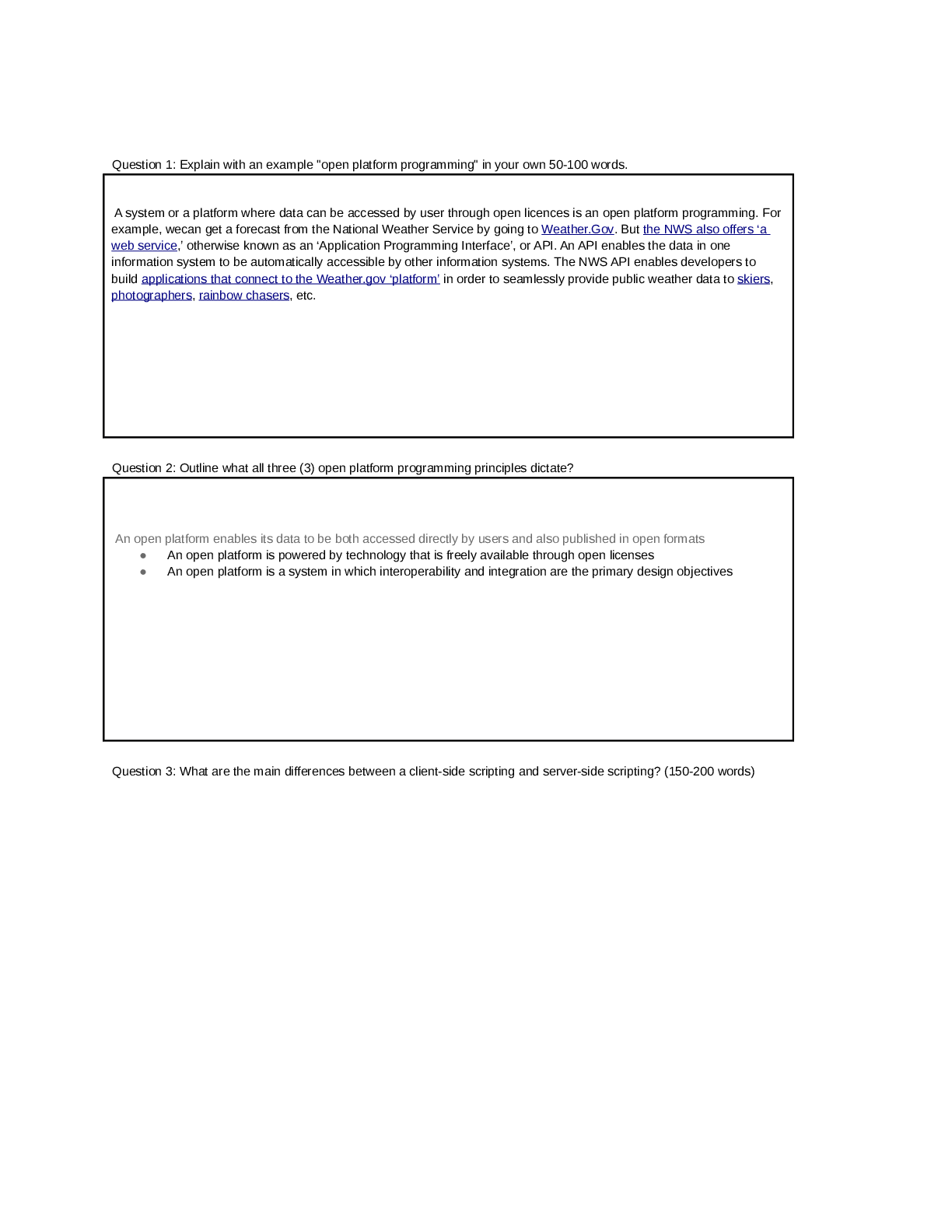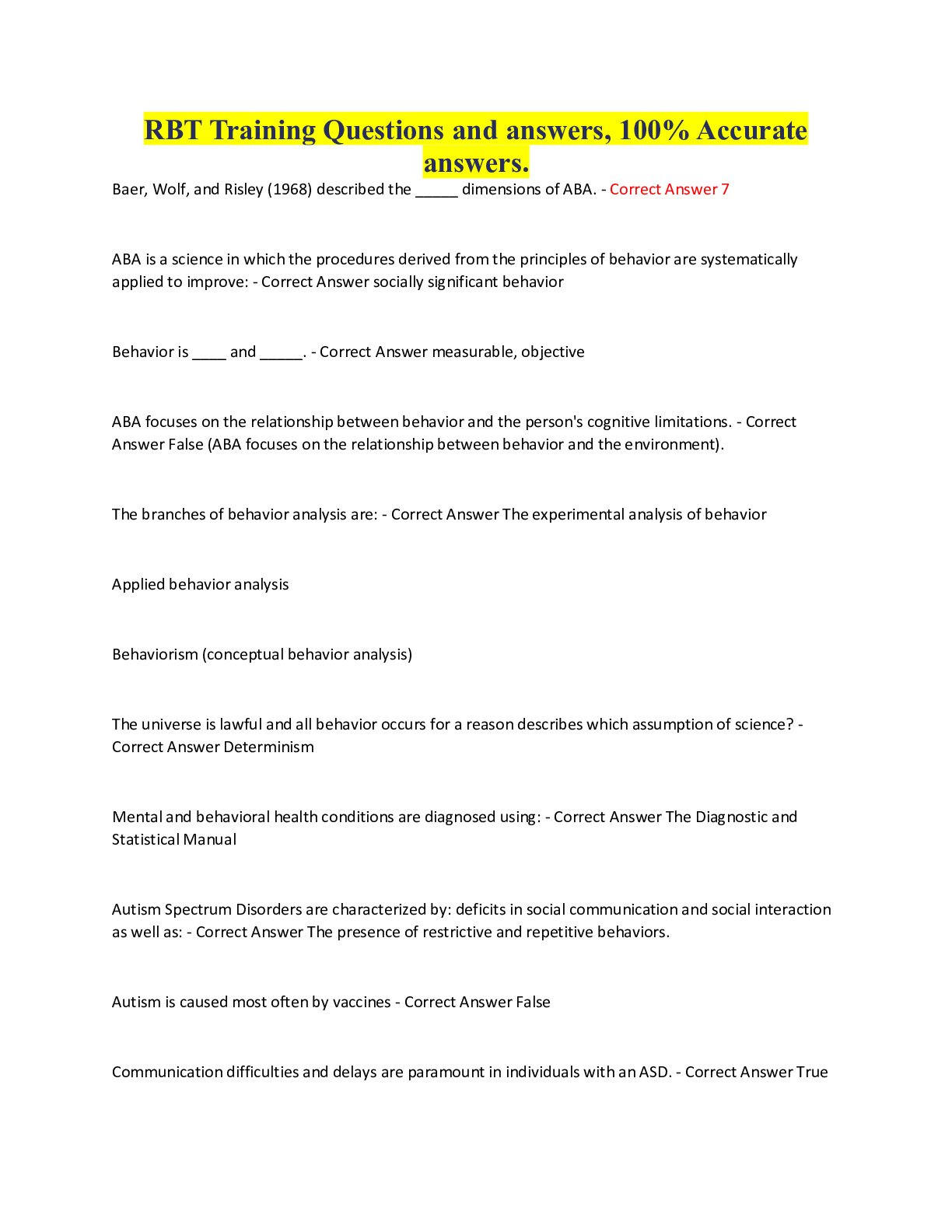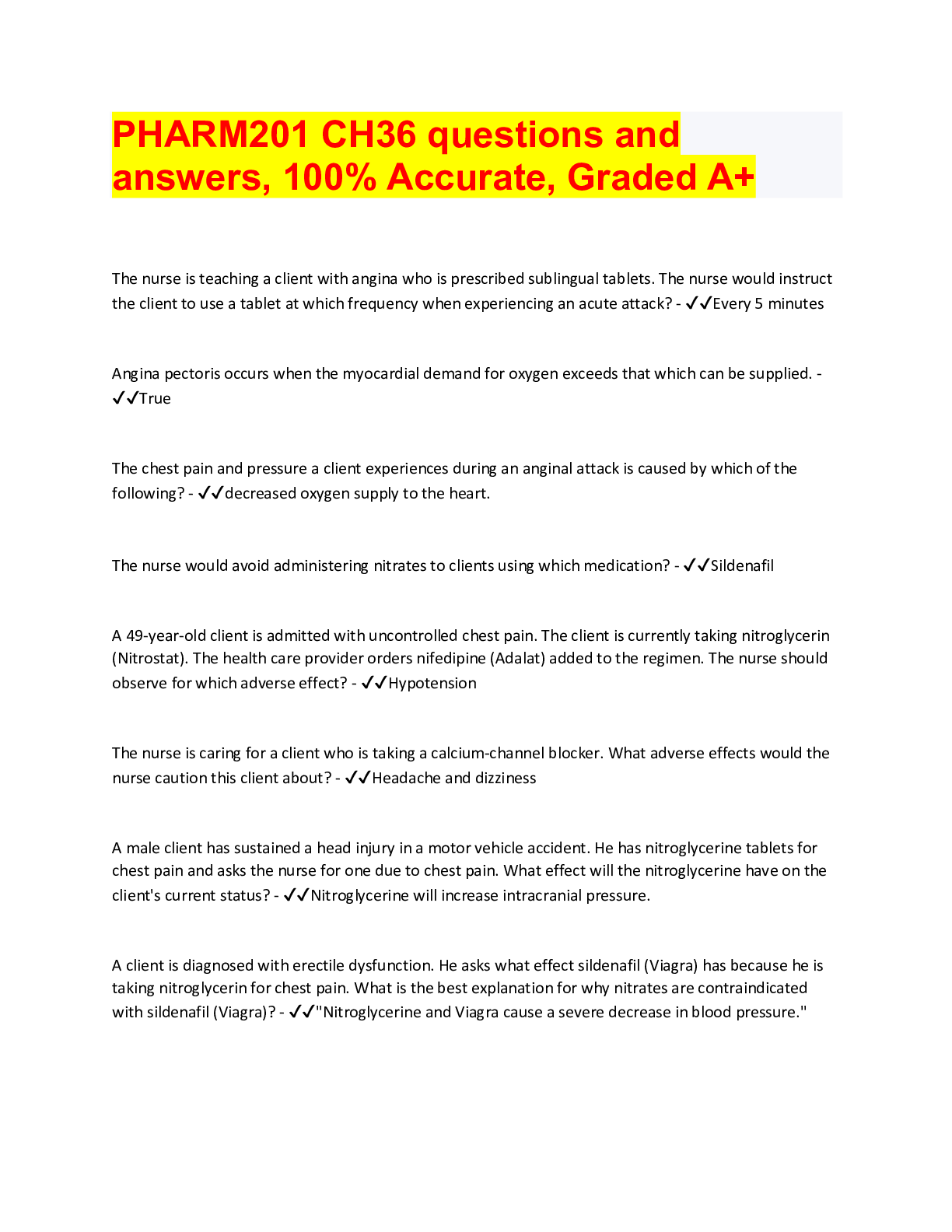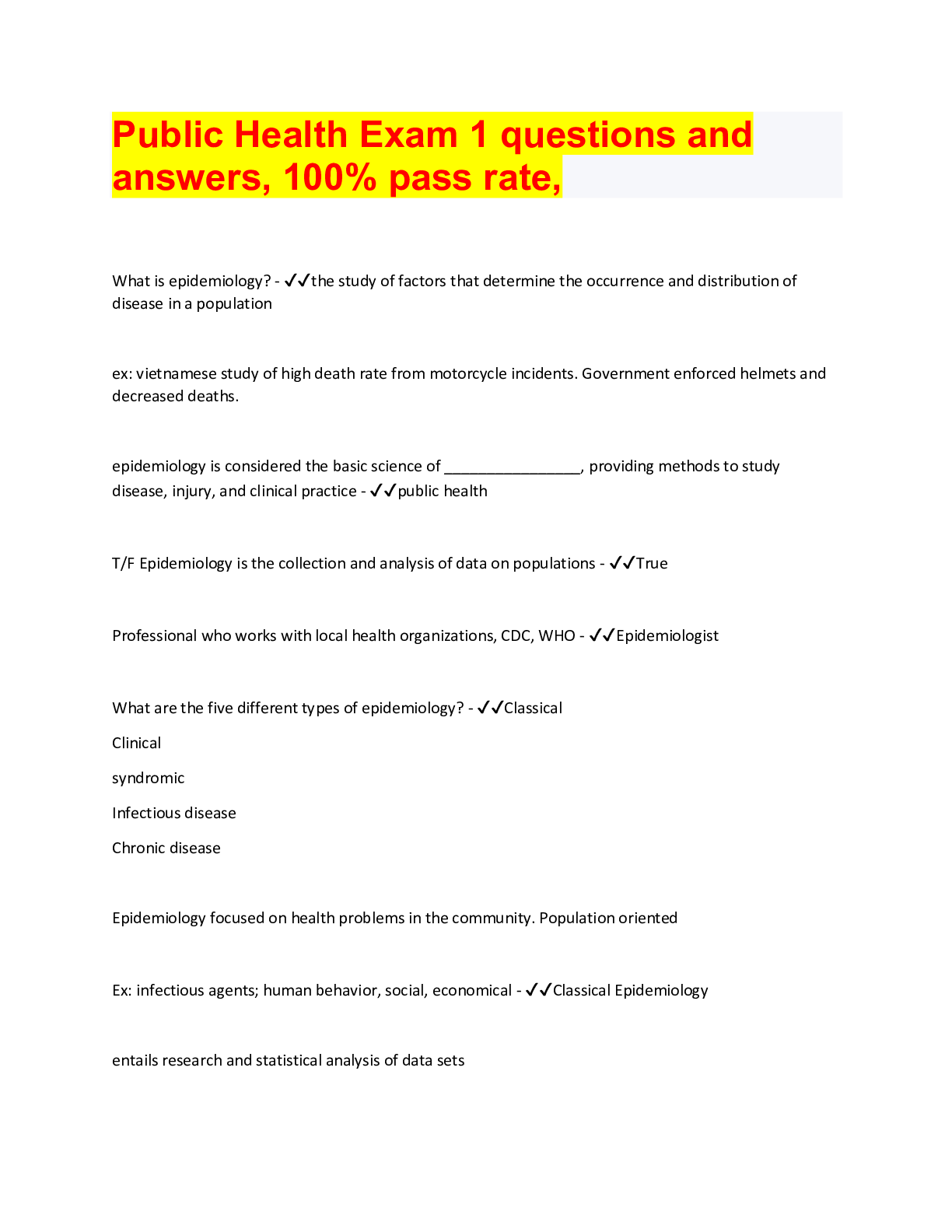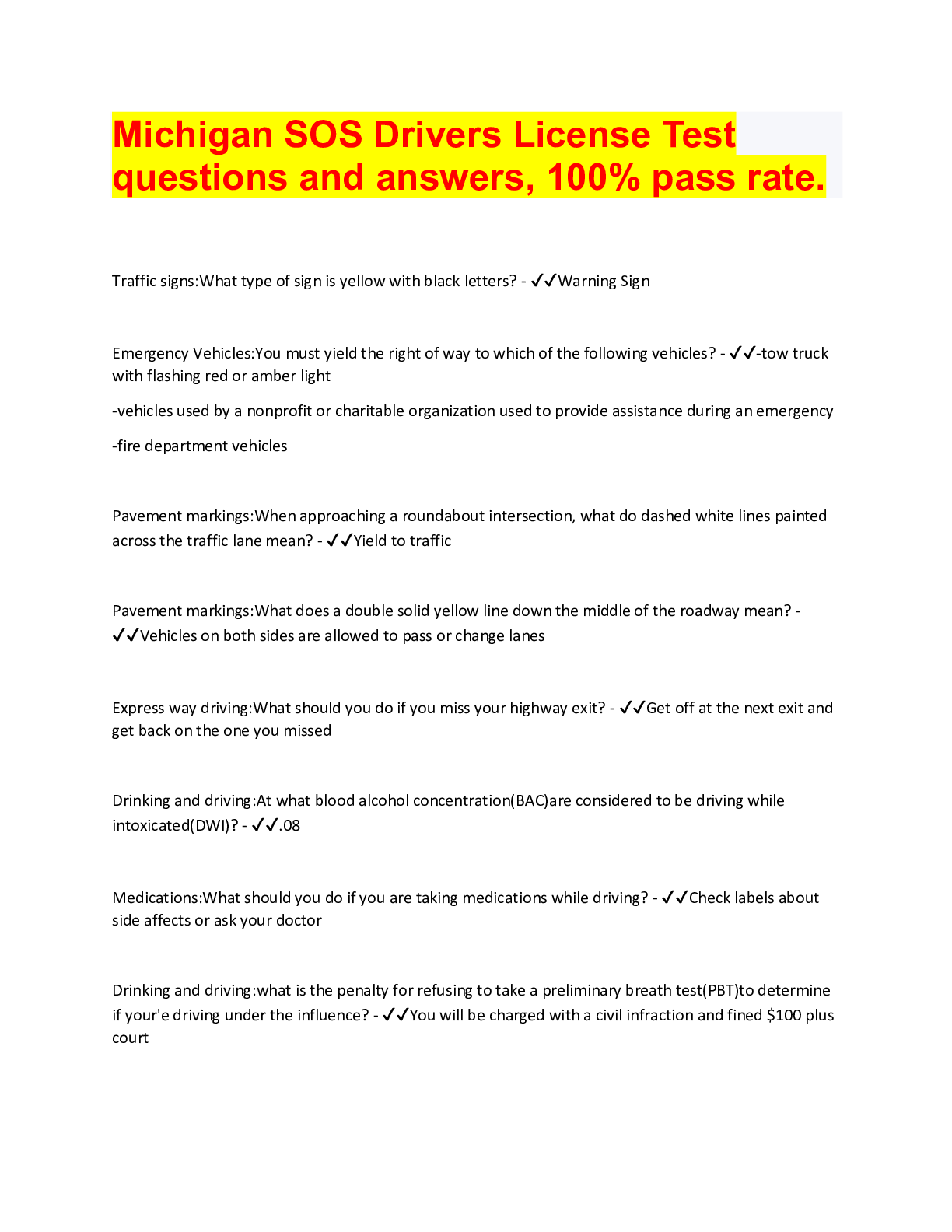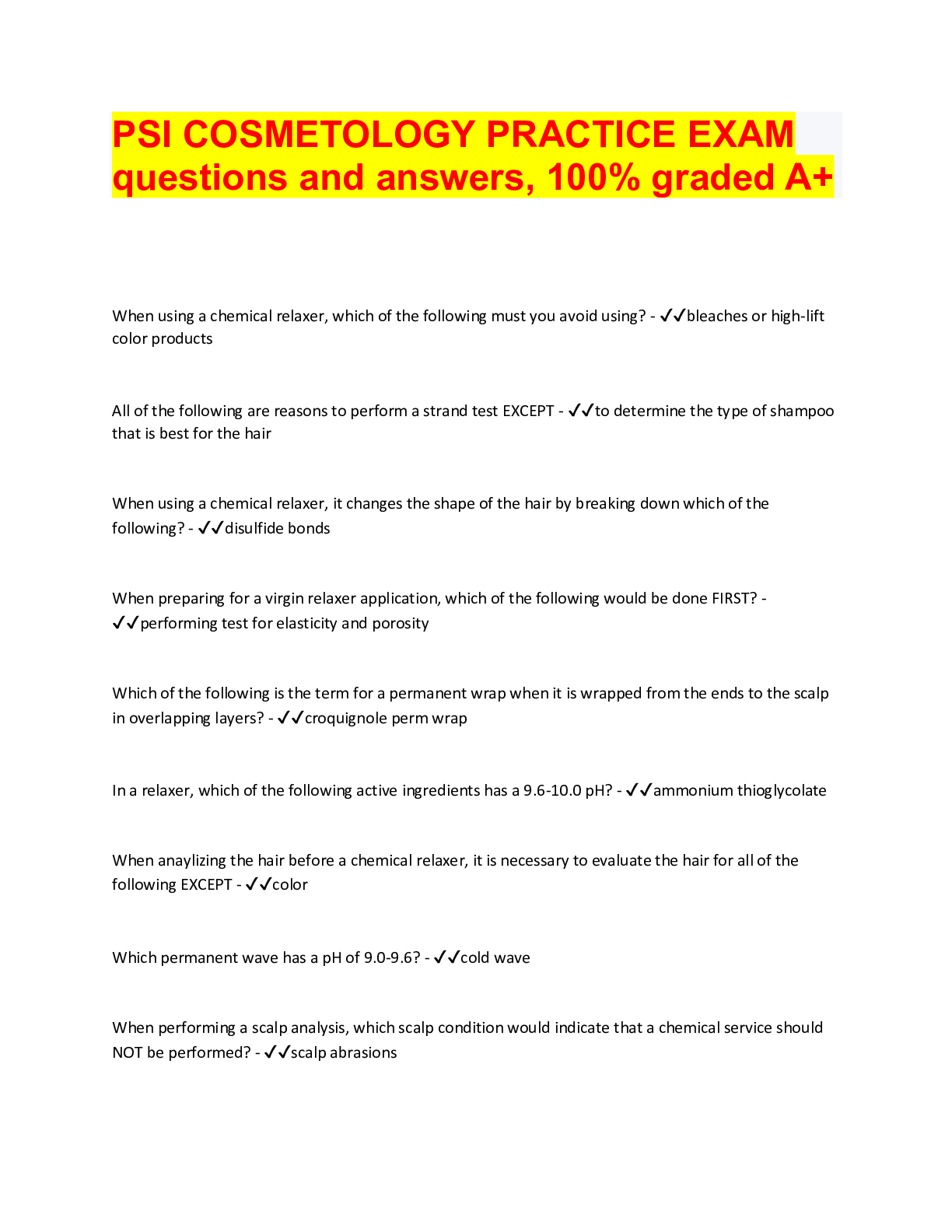*NURSING > QUESTIONS & ANSWERS > NCLEX Cancer ALL KINDS, Questions and answers, 100% Accurate, 2022/2023. (All)
NCLEX Cancer ALL KINDS, Questions and answers, 100% Accurate, 2022/2023.
Document Content and Description Below
NCLEX Cancer ALL KINDS, Questions and answers, 100% Accurate, 2022/2023. The community health nurse is instructing a group of young female clients bout breast self-examination. The nurse should ins... truct the clients to perform the examination at which time? A. At the onset of menstruation B. Every month during ovulation C. Weekly at the same time of day D. 1 week after menstruation begins - ✔✔Answer: D Rationale: The breast self-examination should be performed monthly, 7 days after the onset of the menstrual period. Performing the examination weekly is not recommended. At the onset of menstruation and during ovulation, hormonal changes occur that may alter breast tissue. The nurse is caring for a client following a mastectomy. Which nursing intervention would assist in preventing lymphedema of the affected arm? A. Placing cool compresses on the affected arm B. Elevating the affected arm on a pillow above heart level C. Avoiding arm exercises in the immediate post-operative period. D. Maintaining an intravenous site below the antecubital area of the affected side - ✔✔Answer: B Rationale: Following mastectomy, the arm should be elevated above the level of the heart. Simple arm exercises should be encouraged. No blood pressure readings, injections, intravenous lines, or blood draws should be performed on the affected arm. Cool compresses are not a suggested measure to prevent lymphedema from occurring While being prepared for a biopsy of a lump in the right breast, the patient asks the nurse what the difference is between a benign tumor and a malignant tumor. The nurse explains that a benign tumor differs from a malignant tumor in that benign tumors A. Do not cause damage to adjacent tissue. B. Do not spread to other tissues and organs. C. Are simply an overgrowth of normal cells. D. Frequently recur in the same site. - ✔✔Answer: B Rationale: The major difference between benign and malignant tumors is that malignant tumors invade adjacent tissues and spread to distant tissues and benign tumors never metastasize. Both types of tumors may cause damage to adjacent tissues. The cells differ from normal in both benign and malignant tumors. Benign tumors usually do not recur. For a female client with newly diagnosed cancer, the nurse formulates a nursing diagnosis of Anxiety related to the threat of death secondary to cancer diagnosis. Which expected outcome would be appropriate for this client? A. "Client verbalizes feelings of anxiety." B. "Client doesn't guess at prognosis." C. "Client uses any effective method to reduce tension." D. "Client stops seeking information." - ✔✔Answer: A Rationale: Verbalizing feelings are the client's first step in coping with the situational crisis. It also helps the health care team gain insight into the client's feelings, helping guide psychosocial care. Suppressing speculation may prevent the client from coming to terms with the crisis and planning accordingly. Some methods of reducing tension, such as illicit drug or alcohol use, may prevent the client from coming to terms with the threat of death as well as cause physiologic harm. Seeking information can help a client with cancer gain a sense of control over the crisis A patient has undergone a mastectomy. The nurse determines that the client is having the most difficulty adjusting to the loss of the breast if which behavior is observed? A. Performs arm exercises B. Refuses to look at the dressing C. Reads the post operative care booklet D. Requests pain medication when needed - ✔✔Answer: B Rationale: The patient demonstrated the most difficult adjustments to the loss if she refuses to look at the dressing. This indicates that the client is not ready or willing to begin to acknowledge and cope with the surgery. Performing arm exercises is an action oriented behavior on the part of the patient and is considered a positive sign of adjustment. Reading the post operative care booklet indicates an interest in self care and is a positive action oriented option that is helpful, although there is no direct connection to adjustment to the loss of the breast. A nurse is counseling the family of patient who has terminal breast cancer about palliative care. The nurse explains that which of the following are goals of palliative care? Select all that apply. A. Delays death B. Offers a support system C. Provides relief from pain D. Enhances the quality of life E. Focuses only on the patient not the family F. Manages symptoms of disease and therapies - ✔✔Answers: B, C, D, F Rationale: Palliative care is a philosophy of total care. Palliative care goals include the following: providing relief from pain and other distressing symptoms, affirming life and regarding dying as a normal process, neither hastening nor postponing death, integrating psychological and spiritual aspects of client care, offering a support system to help the client live as actively as possible until death, offering a support system to help families cope during the client's illness and their own bereavement, and enhancing the quality of life. The nurse is caring for a client admitted to the surgical unit following a right modified radical mastectomy. The nurse includes which of the following in the nursing plan of care? A. Take blood pressure in the right arm only. B. Draw serum laboratory samples from the right arm only. C. Position the client supine with the right arm elevated on a pillow. D. Check the right posterior axilla area when assessing the surgical dressing. - ✔✔Answer: D Rationale: If there is drainage or bleeding from the surgical site after a mastectomy, gravity will cause the drainage to seep down and soak the posterior axillary portion of the drainage first. The nurse checks this area to detect early bleeding. The patient should be positioned with the head of the bed in semi-Fowler's position and the arm elevated on pillows to decrease edema. Edema is likely to occur because lymph drainage channels have been resected during the surgical procedure. Blood pressure management, venipuncture, and intra-venous sites should not involve use of the operative arm. The nurse is caring for a young woman who is dying from breast cancer. The nurse determines that a defining characteristic of anticipatory grieving is present when the young woman: A. Discusses thoughts and feelings related to the loss. B. Has prolonged emotional reactions and outbursts. C. Verbalizes unrealistic goals and plans for the future. D. Ignores untreated medical conditions that require treatment. - ✔✔Answer: A Rationale: The nurse can determine the client's stage of grief by observing the client's behavior. This is important because the appropriate nursing diagnoses must be developed so that the plan of care is appropriate. A 58 year old female is concerned about her risk for developing breast cancer. She began menarche at age 14, had 3 children before the age of 35, went through menopause at age 50 with an associated weight gain of 20 lbs. Which of the risk factors would contribute to this client's risk of developing breast cancer? A. menarche at age 14 B. children before the age of 35 C. postmenopausal obesity D. menopause at age 50 - ✔✔Answer: C Rationale: Postmenopausal obesity is a risk factor for developing breast cancer A nurse is teaching a group of women about the appropriate method for performing a breast self-exam (BSE). Which of the following statements regarding breast self-exam demonstrates correct comprehension of the material? A. "Breast exams should begin around age 30." B. "Breast exams should be done one week prior to the menstrual cycle." C. "Breast exams should incorporate both feeling and looking at the breasts." D. "Breast exams should be done during the middle of the menstrual cycle." - ✔✔Answer C Rationale: Breast exams should incorporate both feeling and looking at the breasts. Premenstrual swelling and tenderness of the breasts may be present one week prior. Breast self-examination should begin as early as possible, preferably when the individual is an adolescent. At a senior citizen program, the nurse who was invited to speak to the group is teaching them about detecting the early signs of cancer. Which of the following should the nurse include? A: Do not overexpose yourself to the sun B: Exercise for no more than 7 minutes a day C: Lower the amount of fats in your diet D: Do a monthly breast self-exam - ✔✔Answer: D: Do a monthly breast self-exam Rationale: Monthly breast exams aid in early detection of cancer. Changing the patients diet and limiting exposure to the sun may help with prevention but not detection. The nurse is caring for a 35-year old patient receiving radiation and chemotherapy. Which statement by the patient indicates that he is using a positive coping mechanism that is useful during treatments? A: I may miss my own hair, but I have chosen a nice wig to wear B: Losing my hair won't bother me at all C: I'm never going to leave the house if I am bald D: I will not lose my hair and I'll make sure of that - ✔✔Answer: A: I may miss my own hair, but I have chosen a nice wig to wear Rationale: Expressing personal feelings and positive interventions demonstrate positive coping mechanisms The nurse is visiting a patient receiving radiation therapy. Which of the following statements is incorrect and requires additional teaching? A: "I may lose the ability to sweat" B: "To keep the radiation from burning my skin, I will use lotion" C: "I need to check my mouth frequently for signs of irritation" D: "During radiation therapy, I may lose some of my hair and foods may not taste right" - ✔✔Answer: B: "To keep the radiation from burning my skin, I will use lotion" Rationale: Skin products must be prescribed by the physician because they can irritate the skin A client undergoing radiation therapy has a severely depressed WBC count. The nurse should include which priority nursing intervention in the plan of care? A: Place the client in a private room and maintain strict aseptic technique with all procedures B: Encourage the client to include fresh fruits and vegetables in the diet C: Educate the client to avoid shaving with a razor D: Encourage frequent visitors to reduce the client's feelings of isolation - ✔✔Answer: A: Place the client in a private room and maintain strict aseptic technique with all procedures Rationale: The immunosuppressed client is at a high risk for infection. A private room, maintaining aseptic technique, and limiting visitors will reduce exposure and risk. The nurse is making a home visit to a client receiving external radiation therapy on an outpatient basis. Further teaching is necessary when the nurse observes the client doing which of the following? A: Washing radiation site with plain water and patting skin dry B: Protecting skin with soft, loose clothing C: Applying lotion to irritated skin D: Inspecting skin for damage - ✔✔Answer: C: Applying lotion to irritated skin Rationale: Lotion, deodorant, and powders should not be applied to the radiation site during the treatment period to avoid further irritation to the skin. A hospitalized client with an internal radiation implant calls the nurse to the room to report the implant is dislodged and is lying in the bed. The nurse's actions would include which of the following? A: Apply gloves and place implant in a biohazard bag B: Use long-handled forceps to pick up the implant and place it into lead container C: Have client pick up the implant and place it into lead container D: Notify infection control personnel to dispose of implant - ✔✔Answer: B: Use long-handled forceps to pick up the implant and place it into lead container Rationale: Direct handling of the implant causes exposure to radiation and no one should directly touch the implant. Gloves and biohazard bags do not offer protection from radiation. Long-handled forceps should be used to pick up the implant and lead containers are necessary to prevent exposure to radiation. When teaching safety precautions to the client with internal radiation implant, the nurse would include which statement in explanations to the client? A: No precautions are necessary for internal radiation therapy implants B: The client poses a risk of radiation exposure to others C: The client must remain in solitary isolation for the entire hospitalization D: Visitors should maintain a distance of 30 feet from the client at all times - ✔✔Answer: B: The client poses a risk of radiation exposure to others Rationale: Internal radiation is emitted outward to people in close contact as long as the implant is in place. Therefore, certain precautions to protect others must be taken: The client should have a private room, and visitors should maintain a distance of 6 feet and limit visits to 10-30 minutes. A recently divorced male who has undergone radiation therapy for testicular cancer tells the nurse he is unable to achieve an erection. Which of the following nursing diagnoses is most appropriate? A: Ineffective coping related to the effects of radiation therapy B: Sexual dysfunction related to the effects of radiation therapy C: Disturbed body image related to the effects of radiation therapy D: Imbalanced nutrition: Less than body requirements related to radiation therapy - ✔✔Answer: B: Sexual dysfunction related to the effects of radiation therapy Rationale: Radiation may cause sexual dysfunction. Libido may only be temporarily affected, and the client should be provided with emotional support. Nausea and vomiting are common adverse effects of radiation. When should a nurse administer antiemetics? A: 30 minutes before the initiation of therapy B: With the administration of therapy C: Immediately after nausea begins D: When therapy is completed - ✔✔Answer: A: 30 minutes before the initiation of therapy Rationale: Antiemetics are most beneficial when given before the onset of nausea and vomiting. If the antiemetic was given with the medication or after the medication, it could lose its maximum effectiveness when needed. After surgery for gastric cancer, a client is scheduled to undergo radiation therapy. It will be most important for the nurse to include information about which of the following in the client's teaching plan? A: Nutritional intake B: Management of alopecia C: Exercise and activity levels D: Access to community resources - ✔✔Answer: A: Nutritional intake Rationale: Clients who have had gastric surgery are prone to postoperative complications, such as dumping syndrome and postprandial hypoglycemia, which can affect nutritional intake. Vitamin absorption can also be an issue, depending on the extent of the gastric surgery. Radiation therapy to the upper gastrointestinal area also can affect nutritional intake by causing anorexia, nausea, and esophagitis. The client would not be expected to develop alopecia. Exercise and activity levels as well as access to community resources are important teaching areas, but nutritional intake is a priority need. Which of the following is correct about the rate of cell growth in relation to chemotherapy? A. Faster growing cells are less susceptible to chemotherapy B. Non dividing cells are more susceptible to chemotherapy C. Faster growing cells are more susceptible to chemotherapy D. Slower growing cells are more susceptible to chemotherapy - ✔✔ANSWER C The faster the cell grows the more susceptible it is to chemotherapy, During the administration of a chemotherapeutic drug, the nurse observes that there is a lack of blood return from the intravenous catheter. The priority action by the nurse would be to A. stop the administration of the drug immediately B. reposition the client's arm and continue with the administration of the drug C. apply a tourniquet to the patient's affected arm and notify the doctor D. continue to administer the drug and assess for edema at the IV site - ✔✔Answer A Chemotherapeutic agents are irritating to tissues. Lack of blood return from the IV catheter indicates that it is out of vein. Therefore, administration of the drug should be stopped immediately 3) A nurse is instructing a client how to decrease nausea secondary to chemotherapy and radiation. The nurse understands that the client needs more teaching if the client states, "I will try A. eating small, frequent meals" B. Staying upright for at least on hour during meals" C. Avoiding a lot of liquids with my meals" D. Increasing the amount of unsaturated fats in my diet" - ✔✔Answer - D - increasing the amount of unsaturated fats in my diet" 4) The nurse is developing a plan of care for a client being admitted to the hospital who is immunosuppressed and will be placed on neutropenic precautions. With regard to neutropenic precautions, which intervention is incorrect? A) admitting the client to a semi-private room B) placing a precaution sign on the door to the room C) placing a mask on the client if the client leaves the room D) removing a vase with fresh flowers left by a previous client - ✔✔Answer: A - admitting the client to a semiprivate room 5) A nurse is caring for a client who was admitted to receive chemotherapy for treatment of ovarian cancer. The client vomited after each previous dose of chemotherapy. Which of the following actions should the nurse take to prevent vomiting? A. Speak to the provider about decreasing the chemotherapy dose B. Withhold food and fluids prior to and during treatment C. Provide the client with an emesis basin during treatment D. Administer and antiemetic prior to chemotherapy - ✔✔Answer: D - Administer an antiemetic prior to chemotherapy 6) Previous administrations of chemotherapy agents to a cancer patient have resulted in diarrhea. Which of the following dietary modifications should the nurse recommend? A. A bland, low-fiber diet B. A high-protein, high-calorie diet C. A diet high in fresh fruits and vegetables D. A diet emphasizing whole and organic foods - ✔✔Answer: A - A bland, low-fiber diet 7) The nurse is caring for a patient receiving an initial dose of chemotherapy to treat a rapidly growing metastatic colon cancer. The nurse is aware that this patient is at risk for tumor lysis syndrome (TLS) and will monitor the patient closely for which of the following abnormalities associated with this oncologic emergency? A. Hypokalemia B. Hypocalcemia C. Hypouricemia D. Hypophosphatemia - ✔✔Answer: B - Hypocalcemia The nurse is caring for a patient suffering from anorexia secondary to chemotherapy. Which of the following strategies would be most appropriate for the nurse to use to increase the patient's nutritional intake? A) Increase intake of liquids at mealtime to stimulate appetite. B) Serve three large meals per day plus snacks between each meal C) Avoid the use of liquid protein supplements to encourage eating at mealtime D) Add items such as skim milk powder, cheese, honey, or peanut butter to selected foods - ✔✔Answer: D - Add items such as skim milk powder, cheese, honey, or peanut butter to selected foods. 9) Which of the following nursing diagnoses is most appropriate for a patient experiencing myelosuppression secondary to chemotherapy for cancer treatment? A. Acute pain B. Hypothermia C. Powerlessness D.Risk for infection - ✔✔Answer: D - Risk for infection 10. What would be most important for the nurse to teach the patient to protect themselves from infection? A) Avoiding crowds and taking antipyretics such as Aspirin TID to avoid a fever. B) Assessing their vital signs weekly and reporting a persistent fever of 102 degrees or greater. C) Bathing daily and washing their hands frequently, especially after using restroom or handling contaminated objects. D) Interacting only with individuals who have recently been vaccinated with live or attenuated vaccines. - ✔✔Answer: C - Bathing daily and washing their hands frequently, especially after using restroom or handling contaminated objects. 1).The nurse is taking the social history of a client diagnosed with SCLC (Single Cell Lung Cancer).Which information is significant for this disease? 1. Worked with asbestos for a short time many years ago. 2. Has no family Hx of this type of lung cancer. 3. Has numerous tattoos on upper and lower arms. 4. Has smoked 2 packs of cigarettes/day for 20 years. - ✔✔Answer: 4- Has smoked 2 packs of cigarettes/day for 20 years. Rational: Smoking is greatest risk for LC. 2). The client is 4 hours post-lobectomy for lung cancer. Which assessment data warrants immediate intervention by the nurse? 1. Intake of 1500 mL IV and output of 1000 mL. 2. 450 mL of bright red drainage in the chest tube. 3. Complaining of pain at a 10 on a 1-10 scale. 4. Absent lung sound on the side of surgery. - ✔✔Answer: 2- 450 mL of bright red drainage in the chest tube. Rational: This is about a pint of blood and could indicate a hemorrhage. HINT: Blood is always a priority. 3). Which clinical manifestation would the nurse expect to find in newly diagnosed intrinsic LC? 1. Dysphagia 2. Foul smelling breath 3. Hoarseness 4. Weight loss - ✔✔Answer: 3- Hoarseness Rational: Hoarseness is an early sign. 4). A 69-year-old patient was diagnosed with lung cancer. He is receiving chemotherapy and the nurse caring for him reviewed the laboratory results showing a platelet count is 18,000/mm3 and a pH of 7.36. Which of the following measures would the nurse implement based on the laboratory result? 1. Contact isolation 2. Reverse isolation 3. Respiratory isolation 4. Bleeding precautions - ✔✔Answer: 4- Bleeding precautions Rational: Normal platelet count is 150,000-400,000/mm3. Bleeding precautions should be implemented with a platelet count below 50,000/mm3. Patients receiving chemotherapy are at risk for thrombocytopenia. Bleeding precautions include avoiding anticoagulant and antiplatelet medications, using an electric razor, stool softeners to prevent straining, and avoiding dental floss. 5). A 71-year-old patient diagnosed with lung cancer is receiving chemotherapy on an outpatient basis. The nurse must provide which of the following home care instructions to the patient? 1. During chemotherapy, use disposable plates and plastic utensils 2. All members of the family can share a bathroom 3. Do not consider urine and stool as contaminated 4. If necessary, contaminated linens should be washed separately and then washed a second time with other laundry. - ✔✔Answer: 4- If necessary, contaminated linens should be washed separately and then washed a second time with other laundry. Rational: Any contaminated linen or clothing should be washed separately and then washed a second time with other laundry to prevent exposure to chemotherapy in body fluids. 6). A client with carcinoma of the lung develops syndrome of inappropriate antidiuretic hormone (SIADH) as a complication of the cancer. The nurse anticipates that which of the following may be prescribed? Select all that apply 1. Radiation 2. Chemotherapy 3. Increased fluid intake 4. Serum sodium levels 5. Decreased oral sodium intake 6. Medication that is antagonistic to antidiuretic hormone - ✔✔Answer: 1,2,4,6 Rational: Cancer is a common cause of syndrome of inappropriate antidiuretic hormone (SIADH). In SIADH, excessive amounts of water are reabsorbed by the kidney and put into the systemic circulation. The increased water causes hyponatremia (decreased serum sodium levels) and some degree of fluid retention. The syndrome is managed by treating the condition and cause and usually includes fluid restriction, increased sodium intake, and medication with a mechanism of action that is antagonistic to antidiuretic hormone. Sodium levels are monitored closely because hypernatremia can develop suddenly as a result of treatment. The immediate institution of appropriate cancer therapy, usually radiation or chemotherapy, can cause tumor regression so that antidiuretic hormone synthesis and release processes return to normal. 7). A client with suspected lung cancer is scheduled for thoracentesis as part of the diagnostic workup. The nurse reviews the client's history for conditions that might contraindicate this procedure. Which condition is a contraindication for thoracentesis? 1. A seizure disorder 2. Chronic obstructive pulmonary disease (COPD) 3. Anemia 4. A bleeding disorder - ✔✔Answer: 4- A bleeding disorder Rational: A bleeding disorder is a contraindication for thoracentesis because a hemorrhage may occur during or after this procedure, possibly causing death. Although a history of a seizure disorder, COPD, or anemia calls for caution, it doesn't contraindicate thoracentesis. 8). A nurse is teaching a client who is receiving radiation treatment for left lower lobe lung cancer. Which client statement indicates a need for further treatment? 1. "I'll use hats to protect my head from the sun when my hair falls out" 2. "If I get nauseous, I'll try to eat several small, bland meals each day" 3. "I'll allow myself plenty of time to rest between activities" 4. "Most of the adverse effects should go away shortly after my last radiation treatment" - ✔✔Answer: 1-"I'll use hats to protect my head from the sun when my hair falls out" Rational: The client requires additional teaching if he mentions that he will lose the hair on his head a result of radiation therapy. Alopecia as an acute, localized adverse effect of radiation. The treatment area for this client's cancer will be localized to the lower aspects of his lungs, not his head. Nausea and fatigue are expected generalized adverse effects of radiation therapy. Most adverse effects of radiation are temporary and will stop when treatment is complete. 9). A patient who smokes tells the nurse, "I want to have a yearly chest x-ray so that if I get cancer, it will be detected early." Which response by the nurse is most appropriate? 1. "Chest x-rays do not detect cancer until tumors are already at least a half-inch in size." 2. "Annual x-rays will increase your risk for cancer because of exposure to radiation." 3. "Insurance companies do not authorize yearly x-rays just to detect early lung cancer." 4. "Frequent x-rays damage the lungs and make them more susceptible to cancer." - ✔✔Answer: 1-"Chest x-rays do not detect cancer until tumors are already at least a half-inch in size." Rational: A tumor must be at least 1 cm large before it is detectable by an x-ray and may already have metastasized by that time. Radiographs have low doses of radiation, and an annual x-ray alone is not likely to increase lung cancer risk. Insurance companies do not usually authorize x-rays for this purpose, but it would not be appropriate for the nurse to give this as the reason for not doing an x-ray. A yearly x-ray is not a risk factor for lung cancer. 10). Which of the following is the primary goal for surgical resection of lung cancer? 1. To remove the tumor and all surrounding tissue 2. To remove the tumor and as little surrounding tissue as possible 3. To remove the entire tumor and any collapsed alveoli in the same region 4. To remove as much of the tumor as possible, without removing any alveoli - ✔✔Answer: 2- To remove the tumor and as little surrounding tissue as possible Rational: The goal of surgical resection is to remove the lung tissue that has a tumor in it while saving as much surrounding tissue as possible. It may be necessary to remove alveoli and bronchioles, but care is taken to make sure only what's absolutely necessary is removed. A female client has a mother who died from ovarian cancer and sister diagnosed with it. Which recommendations should the nurse make regarding early detection of ovarian cancer? A:The client should consider having a prophylactic bilateral oophorectomy B:The client should have a trans-vaginal ultrasound and a CA-125 lab test every 6 months C:The client should have yearly MRI scans D:The client should have a biannual gyn exam with flexible sigmoidoscopy - ✔✔Answer: B. The client should have a trans-vaginal ultrasound and a CA-125 lab test every 6 months Rationale: A trans-vaginal ultrasound is a sonogram probe is inserted into the vagina and sound waves are directed toward the ovaries. The CA-125 tumor marker is elevated in several cancers. It is nonspecific but, coupled with the sonogram, can provide info about ovarian cancer for early diagnosis. A 22 year old client asks about the purpose of the HPV vaccine (Gardasil). What is an appropriate nursing explanation? A. It is to lower the risk of contracting melanoma. B. It is a vaccine that prevents infection by all strains of HPV. C. The vaccine treats infections of HPV. D. The vaccine can lower the risk of cervical cancer. - ✔✔Answer: D. The vaccine can lower the risk of cervical cancer. Rationale: The HPV vaccine can prevent infection by certain strains of HPV, not all strains. It is useful in that it can lower the risk of developing cervical cancer. It does not treat preexisting infection, but can prevent infection by other types. In educating a client, what would the nurse NOT mention as a risk factor that increases the risk of developing endometrial cancer? A. Obesity B. Increased age C. Having had several children D. Diabetes - ✔✔Answer: C. Having had several children. Mina, who is suspected of an ovarian tumor, is scheduled for a pelvic ultrasound. The nurse provides which pre-procedure instruction to the client? A. Eat a light breakfast only B. Maintain an NPO status before the procedure C. Wear comfortable clothing and shoes for the procedure D. Drink six to eight glasses of water without voiding before the test - ✔✔Answer: D. Drink six to eight glasses of water without voiding before the test Rationale: A pelvic ultrasound requires the ingestion of large volumes of water just before the procedure. A full bladder is necessary so that it will be visualized as such and not mistaken for a possible pelvic growth. An abdominal ultrasound may require that the client abstain from food or fluid for several hours before the procedure. Option C is unrelated to this specific procedure. The husband of a client with cervical cancer says to the nurse, "The doctor told my wife that her cancer is curable. Is he just trying to make us feel better?" Which would be the nurse's most accurate response? A. "When cervical cancer is detected early and treated aggressively, the cure rate is almost 100%" B. "The 5-year survival rate is about 75%, which makes the odds pretty good." C. "Saying a cancer is curable means that 50% of all women with the cancer survive at least 5 years." D. "Cancers of the female reproductive tract tend to be slow-growing and respond well to treatment." - ✔✔Answer: A. "When cervical cancer is detected early and treated aggressively , the cure rate is almost 100%" Rationale: When cervical cancer is detected early and treated aggressively, the cure rate approaches 100%. The incidence of cervical cancer has increased among African Americans, Native Americans, and Latinas, and these women often have a poorer prognosis because the cancer is not identified early. Papanicolaou (Pap) smears and colposcopy have the potential to decrease mortality from invasive carcinoma when these screening and treatment programs are utilized by women. A 50 year old female client complains of bloating and indigestion and tells the nurse she has gained two inches in her waist recently. Which question should the nurse ask the client? A:"What do you eat before you feel bloated?" B:"Have you had your ovaries removed?" C:"Are your stools darker in color lately?" D:"Is this indigestion worse when you lie down?" - ✔✔Answer: B. "Have you had your ovaries removed?" Rationale: Ovarian Cancer has vague symptoms of abdominal discomfort, but increasing abdominal girth is the most common symptom. If the client has had the ovaries removed, then the nurse could assess for another cause. When planning care for a client being treated for cervical cancer, it would be a priority for the nurse to include which of the following in the plan of care? A. Instruction on birth control methods. B. Vigorous fluid hydration. C. Assessment of sexual function. D. Daily weights. - ✔✔Answer: C. Assessment of sexual function. Rationale: Surgery and radiation therapy for cervical cancer often result in shortening of the vagina, vaginal dryness, and loss of libido due to emotional issues related to sexuality and femininity. Therefore, the client's feelings about sexuality and the partner's feelings should be assessed. If a client is not sexually active, instructions should be given in the use of a vaginal dilator and lubricant to prevent adhesion of the vaginal walls. While instruction about birth control methods may be needed for some clients, treatment for cervical cancer may include total abdominal hysterectomy, so that this would not be appropriate for all clients. Encouraging fluids and daily weights are not priorities for cervical cancer care. A 58-year-old woman calls the health clinic when she has a moderate amount of vaginal bleeding after 6 years of menopause. The nurse will anticipate scheduling the patient for A. endometrial biopsy. B. dilation and curettage (D&C). C. laser endometrial ablation. D. uterine balloon therapy. - ✔✔Answer: A. endometrial biopsy Rationale: A postmenopausal woman with vaginal bleeding should be evaluated for endometrial cancer, and endometrial biopsy is the primary test for endometrial cancer. D&C will be needed only if the biopsy does not provide sufficient information to make a diagnosis. Endometrial ablation and balloon therapy are used to treat menorrhagia, which is unlikely in this patient A 40-year-old divorced mother of four school-age children is hospitalized with metastatic cancer of the ovary. The nurse finds the patient crying, and she tells the nurse that she does not know what will happen to her children when she dies. The most appropriate response by the nurse is A. "Why don't we talk about the options you have for the care of your children?" B. "Many patients with cancer live for a long time, so there is time to plan for your children." C. "For now you need to concentrate on getting well, not worry about your children." D. "Perhaps your ex-husband will take the children when you can't care for them." - ✔✔Answer: A. "Why don't we talk about the options you have for the care of your children?" Rationale: This response expresses the nurse's willingness to listen and recognizes the patient's concern. The responses beginning "Many patients with cancer live for a long time" and "For now you need to concentrate on getting well" close off discussion of the topic and indicate that the nurse is uncomfortable with the topic. In addition, the patient with metastatic ovarian cancer may not have a long time to plan. Although it is possible that the patient's ex-husband will take the children, more assessment information is needed before making plans. A woman tells the nurse that "there's been a lot of cancer in my family." The nurse should instruct the client to report which possible sign of cervical cancer? A. Pain B. Leg edema C. Urinary and rectal symptoms D. Light bleeding or watery vaginal discharge - ✔✔Answer: D. Light bleeding or watery vaginal discharge. Rationale: In its early stages, cancer of the cervix is usually asymptomatic, which underscores the importance of regular Pap smears. A light bleeding or serosanguineous discharge may be apparent as the first noticeable symptom. Pain, leg edema, urinary and rectal symptoms, and weight loss are late signs of cervical cancer. 1. While being prepared for a biopsy of a lump in the right breast, the patient asks the nurse what the difference is between a benign tumor and a malignant tumor. The nurse explains that a benign tumor differs from a malignant tumor in that benign tumors a. do not cause damage to adjacent tissue. b. do not spread to other tissues and organs. c. are simply an overgrowth of normal cells. d. frequently recur in the same site. - ✔✔B Rationale: The major difference between benign and malignant tumors is that malignant tumors invade adjacent tissues and spread to distant tissues and benign tumors never metastasize. Both types of tumors may cause damage to adjacent tissues. The cells differ from normal in both benign and malignant tumors. Benign tumors usually do not recur. 2. A patient who has been told by the health care provider that the cells in a bowel tumor are poorly differentiated asks the nurse what is meant by "poorly differentiated." Which response should the nurse make? a. "The cells in your tumor do not look very different from normal bowel cells." b. "The tumor cells have DNA that is different from your normal bowel cells." c. "Your tumor cells look more like immature fetal cells than normal bowel cells." d. "The cells in your tumor have mutated from the normal bowel cells." - ✔✔C Rationale: An undifferentiated cell has an appearance more like a stem cell or fetal cell and less like the normal cells of the organ or tissue. The DNA in cancer cells is always different from normal cells, whether the cancer cells are well differentiated or not. All tumor cells are mutations form the normal cells of the tissue. 3. A patient who smokes tells the nurse, "I want to have a yearly chest x-ray so that if I get cancer, it will be detected early." Which response by the nurse is most appropriate? a. "Chest x-rays do not detect cancer until tumors are already at least a half-inch in size." b. "Annual x-rays will increase your risk for cancer because of exposure to radiation." c. "Insurance companies do not authorize yearly x-rays just to detect early lung cancer." d. "Frequent x-rays damage the lungs and make them more susceptible to cancer." - ✔✔A Rationale: A tumor must be at least 1 cm large before it is detectable by an x-ray and may already have metastasized by that time. Radiographs have low doses of radiation, and an annual x-ray alone is not likely to increase lung cancer risk. Insurance companies do not usually authorize x-rays for this purpose, but it would not be appropriate for the nurse to give this as the reason for not doing an x-ray. A yearly x-ray is not a risk factor for lung cancer. 4. In teaching about cancer prevention to a community group, the nurse stresses promotion of exercise, normal body weight, and low-fat diet because a. most people are willing to make these changes to avoid cancer. b. dietary fat and obesity promote growth of many types of cancer. c. people who exercise and eat healthy will make other lifestyle changes. d. obesity and lack of exercise cause cancer in susceptible people. - ✔✔B Rationale: Obesity and dietary fat promote the growth of malignant cells, and decreasing these risk factors can reduce the chance of cancer development. Many people are not willing to make these changes. Good diet and exercise habits are not a guarantee that other healthy lifestyle changes will then occur. Obesity and lack of exercise do not cause cancer, but they promote the growth of altered cells. 5. During a routine health examination, a 30-year-old patient tells the nurse about a family history of colon cancer. The nurse will plan to a. teach the patient about the need for a colonoscopy at age 50. b. ask the patient to bring in a stool specimen to test for occult blood. c. schedule a sigmoidoscopy to provide baseline data about the patient. d. have the patient ask the doctor about specific tests for colon cancer. - ✔✔D Rationale: The patient is at increased risk and should talk with the health care provider about needed tests, which will depend on factors such as the exact type of family history and any current symptoms. Colonoscopy at age 50 is used to screen for individuals without symptoms or increased risk, but earlier testing may be needed for this patient because of family history. For fecal occult blood testing, patients use a take-home multiple sample method rather than bring one specimen to the clinic. The health care provider will take multiple factors into consideration before determining whether a sigmoidoscopy is needed at age 30. 6. When reviewing the chart for a patient with cervical cancer, the nurse notes that the cancer is staged as Tis, N0, M0. The nurse will teach the patient that a. the cancer cells are well-differentiated. b. it is difficult to determine the original site of the cervical cancer. c. further testing is needed to determine the spread of the cancer. d. the cancer is localized to the cervix. - ✔✔D Rationale: Cancer in situ indicates that the cancer is localized to the cervix and is not invasive at this time. Cell differentiation is not indicated by clinical staging. Because the cancer is in situ, the origin is the cervix. Further testing is not indicated given that the cancer has not spread. 7. Which statement by a patient who is scheduled for a needle biopsy of the prostate indicates that the patient understands the purpose of a biopsy? a. "The biopsy will tell the doctor whether the cancer has spread to my other organs." b. "The biopsy will help the doctor decide what treatment to use for my enlarged prostate." c. "The biopsy will determine how much longer I have to live." d. "The biopsy will indicate the effect of the cancer [Show More]
Last updated: 1 year ago
Preview 1 out of 65 pages
Instant download

Buy this document to get the full access instantly
Instant Download Access after purchase
Add to cartInstant download
Reviews( 0 )
Document information
Connected school, study & course
About the document
Uploaded On
Aug 30, 2022
Number of pages
65
Written in
Additional information
This document has been written for:
Uploaded
Aug 30, 2022
Downloads
0
Views
80













